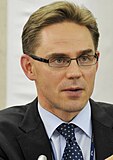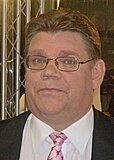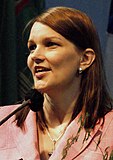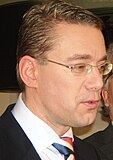
Back الانتخابات البرلمانية الفنلندية 2011 Arabic Eleccions parlamentàries finlandeses de 2011 Catalan Parlamentní volby ve Finsku 2011 Czech Rigsdagsvalget i Finland 2011 Danish Parlamentswahl in Finnland 2011 German Elecciones parlamentarias de Finlandia de 2011 Spanish 2011. aasta Soome parlamendivalimised Estonian Eduskuntavaalit 2011 Finnish Élections législatives finlandaises de 2011 French Eleccións ao Parlamento de Finlandia de 2011 Galician
| |||||||||||||||||||||||||||||||||||||||||||||||||||||||||||||||||||||||||||||||||||||||||||||||||||||||||||||||||||||||
All 200 seats to the Parliament 101 seats needed for a majority | |||||||||||||||||||||||||||||||||||||||||||||||||||||||||||||||||||||||||||||||||||||||||||||||||||||||||||||||||||||||
|---|---|---|---|---|---|---|---|---|---|---|---|---|---|---|---|---|---|---|---|---|---|---|---|---|---|---|---|---|---|---|---|---|---|---|---|---|---|---|---|---|---|---|---|---|---|---|---|---|---|---|---|---|---|---|---|---|---|---|---|---|---|---|---|---|---|---|---|---|---|---|---|---|---|---|---|---|---|---|---|---|---|---|---|---|---|---|---|---|---|---|---|---|---|---|---|---|---|---|---|---|---|---|---|---|---|---|---|---|---|---|---|---|---|---|---|---|---|---|---|
| Turnout | 70.5% 5.5% | ||||||||||||||||||||||||||||||||||||||||||||||||||||||||||||||||||||||||||||||||||||||||||||||||||||||||||||||||||||||
| |||||||||||||||||||||||||||||||||||||||||||||||||||||||||||||||||||||||||||||||||||||||||||||||||||||||||||||||||||||||
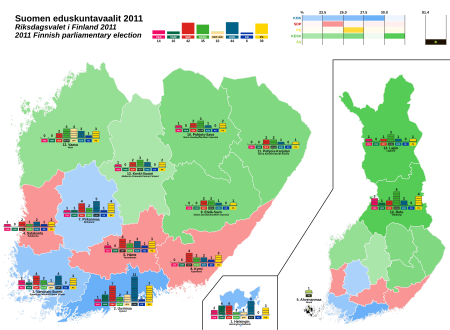 Results map | |||||||||||||||||||||||||||||||||||||||||||||||||||||||||||||||||||||||||||||||||||||||||||||||||||||||||||||||||||||||
| |||||||||||||||||||||||||||||||||||||||||||||||||||||||||||||||||||||||||||||||||||||||||||||||||||||||||||||||||||||||
Parliamentary elections were held in Finland on 17 April 2011 after the termination of the previous parliamentary term. Advance voting, which included voting by Finnish expatriates, was held between 6 and 12 April with a turnout of 31.2%.[1][2]
The importance of the election was magnified due to Finland's capacity to influence the European Union's decision in regard to affecting a bailout for Portugal via the European Financial Stability Facility, as part of financial support systems for debt-laden European countries, and the fall of the Portuguese government. Small differences in the opinion polls for the traditional three big parties (the National Coalition Party, the Centre Party and the Social Democratic Party) and the surprising rise in support for the True Finns also electrified the atmosphere ahead of the election.[3]
The election resulted in a breakthrough for the populist True Finns, which came head-to-head with the three big parties, while every other parliamentary party in mainland Finland, excluding Åland, lost popularity. The National Coalition Party (NCP) also ended up as the biggest party for the first time in its history.[4] The total turnout rose to 70.5% from 67.9% in the previous election; and corruption scandals also resulted in an anti-incumbency vote. The incumbent, Centre Party-led coalition, which included the NCP, Green League and Swedish People's Party (SPP), lost its majority by two seats and their Prime Minister Mari Kiviniemi of the Centre Party signaled that her party would then sit in opposition.
The incumbent Minister of Finance Jyrki Katainen, as the leader of the biggest party in the new parliament, was tasked to form a new government. During government formation talks, the True Finns said they would withdraw if the government accepted the Portuguese bailout. Katainen then continued six-party talks that included the NCP, the SDP, the Left Alliance, Green League, Christian Democrats and the SPP. However, these negotiations ran aground on 1 June as the Social Democrats and the Left Alliance walked out of the talks due to strong differences on economic policies. Negotiations were set to continue under Katainen's proposed premiership, though the composition of the new government was not certain at the time. Due to the Green League's opposition to forming a government with the NCP, the Centre Party and the Christian Democrats, Katainen—avoiding a resultant minority government[5]—announced on 10 June that the same six parties would return to negotiations, describing it as the "only possible coalition."[6] On 17 June, the six parties came to an agreement on forming a coalition government, led by Katainen and consisting of 19 ministers. The ministerial portfolios were divided with the NCP and the SDP both having six ministers, while the Left Alliance, the Greens and the SPP would each have two and the Christian Democrats would have one. The six parties announced their ministers designate between 17–20 June. On 22 June the new parliament elected Jyrki Katainen as prime minister.[7]
- ^ "Election dates". Ministry of Justice. Archived from the original on 9 July 2011. Retrieved 12 July 2011.
- ^ "Perussuomalaiset hyötymässä miesten äänestysinnosta" (in Finnish). MTV3. 13 April 2011. Archived from the original on 30 April 2011. Retrieved 12 July 2011.
- ^ Spiegel, Peter (11 April 2011). "Anger begins to infect Europe's prosperous core". Financial Times. Retrieved 12 July 2011.
- ^ "Katainen villitsi kokoomusväen". Helsingin Sanomat (in Finnish). 17 April 2011. Archived from the original on 12 August 2011. Retrieved 12 July 2011.
- ^ "Vihreät ei lähde porvarihallitukseen" (in Finnish). MTV3. 6 June 2011. Retrieved 12 July 2011.
- ^ "Katainen jatkaa hallitustunnusteluja kuuden puolueen kanssa". Helsingin Sanomat (in Finnish). 10 June 2011. Retrieved 12 July 2011.
- ^ "Uusi hallitus nimitettiin". Helsingin Sanomat (in Finnish). Suomen Tietotoimisto. 22 June 2011. Archived from the original on 25 June 2011. Retrieved 12 July 2011.
© MMXXIII Rich X Search. We shall prevail. All rights reserved. Rich X Search
